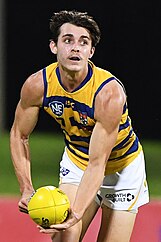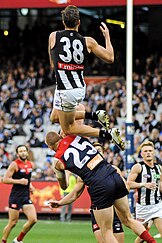Australian rules football
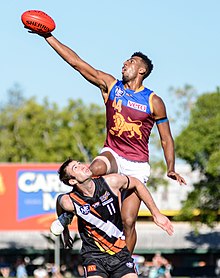 | |
| Highest governing body | AFL Commission |
|---|---|
| Nicknames | Australian football, Aussie rules, football, footy, AFL |
| First played | 15 June 1859 in Melbourne, Australia |
| Registered players | 1,404,176 (2016)[1] |
| Clubs | 25,770 (2016)[1] |
| Characteristics | |
| Contact | Full |
| Team members | 22 (18 onfield, 4 interchange) |
| Mixed-sex | Up to age 14 |
| Type | Outdoor |
| Equipment | Football |
| Glossary | Glossary of Australian rules football |
| Presence | |
| Country or region | Australia |
| Olympic | Demonstration sport, 1956 Melbourne Olympics |
Australian rules football, also called Australian football or Aussie rules,[2] or more simply football or footy, is a contact sport played between two teams of 18 players on an oval field, often a modified cricket ground. Points are scored by kicking the oval ball between the central goal posts (worth six points), or between a central and outer post (worth one point, otherwise known as a "behind").
During general play, players may position themselves anywhere on the field and use any part of their bodies to move the ball. The primary methods are kicking, handballing and running with the ball. There are rules on how the ball can be handled; for example, players running with the ball must intermittently bounce or touch it on the ground. Throwing the ball is not allowed, and players must not get caught holding the ball. A distinctive feature of the game is the mark, where players anywhere on the field who catch the ball from a kick (with specific conditions) are awarded unimpeded possession.[3] Possession of the ball is in dispute at all times except when a free kick or mark is paid. Players can tackle using their hands or use their whole body to obstruct opponents. Dangerous physical contact (such as pushing an opponent in the back), interference when marking, and deliberately slowing the play are discouraged with free kicks, distance penalties, or suspension for a certain number of matches depending on the severity of the infringement. The game features frequent physical contests, spectacular marking, fast movement of both players and the ball, and high scoring.
The sport's origins can be traced to football matches played in Melbourne, Victoria, in 1858, inspired by English public school football games. Seeking to develop a game more suited to adults and Australian conditions, the Melbourne Football Club published the first laws of Australian football in May 1859.[4][5]
Australian football has the highest spectator attendance and television viewership of all sports in Australia,[6][7] while the Australian Football League (AFL), the sport's only fully professional competition, is the nation's wealthiest sporting body.[8] The AFL Grand Final, held annually at the Melbourne Cricket Ground, is the second-highest-attended club championship event in the world. The sport is also played at amateur level in many countries and in several variations. Its rules are governed by the AFL Commission with the advice of the AFL's Laws of the Game Committee.
Name
[edit]Australian rules football is known by several nicknames, including Aussie rules, football and footy.[9] In some regions, where other codes of football are more popular, the sport is most often called AFL after the Australian Football League, while the league itself also uses this name for local competitions in some areas.[10]
History
[edit]Origins
[edit]
Primitive forms of football were played sporadically in the Australian colonies in the first half of the 19th century. Compared to cricket and horse racing, football was considered a mere "amusement" by colonists at the time, and while little is known about these early one-off games, evidence does not support a causal link with Australian football.[12] In Melbourne, in 1858, in a move that would help to shape Australian football in its formative years, private schools (then termed "public schools" in accordance with nomenclature in England) began organising football games inspired by precedents at English public schools.[13] The earliest match, held on 15 June, was between Melbourne Grammar and St Kilda Grammar.[14]
On 10 July 1858, the Melbourne-based Bell's Life in Victoria and Sporting Chronicle published a letter by Tom Wills, captain of the Victoria cricket team, calling for the formation of a "foot-ball club" with a "code of laws" to keep cricketers fit during winter.[15] Born in Australia, Wills played a nascent form of rugby football while a pupil at Rugby School in England, and returned to his homeland a star athlete and cricketer. Two weeks later, Wills' friend, cricketer Jerry Bryant, posted an advertisement for a scratch match at the Richmond Paddock adjoining the Melbourne Cricket Ground (MCG).[16] This was the first of several "kickabouts" held that year involving members of the Melbourne Cricket Club, including Wills, Bryant, W. J. Hammersley and J. B. Thompson. Trees were used as goalposts and play typically lasted an entire afternoon. Without an agreed-upon code of laws, some players were guided by rules they had learned in the British Isles, "others by no rules at all".[17] Another milestone in 1858 was a 40-a-side match played under experimental rules between Melbourne Grammar and Scotch College, held at the Richmond Paddock. Umpired by Wills and teacher John Macadam, it began on 7 August and continued over two subsequent Saturdays, ending in a draw with each side kicking one goal.[18] It is commemorated with a statue outside the MCG, and the two schools have since competed annually in the Cordner–Eggleston Cup, the world's oldest continuous football competition.[19]
Since the 1920s, it has been suggested that Australian football may have been derived from the Irish sport of Gaelic football.[20] However, there is no archival evidence in favour of a Gaelic influence, and the style of play shared between the two modern codes appeared in Australia long before the Irish game evolved in a similar direction.[21][22] Another theory, first proposed in 1983, posits that Wills, having grown up among Aboriginals in Victoria, may have seen or played the Aboriginal ball game of Marn Grook, and incorporated some of its features into early Australian football. There is only circumstantial evidence that he knew of the game, and according to biographer Greg de Moore's research, Wills was "almost solely influenced by his experience at Rugby School".[23]
First rules
[edit]A loosely organised Melbourne side, captained by Wills, played against other football enthusiasts in the winter and spring of 1858.[24] The following year, on 14 May, the Melbourne Football Club was officially established, making it one of the world's oldest football clubs. Three days later, Wills, Hammersley, Thompson and teacher Thomas H. Smith met near the MCG at the Parade Hotel, owned by Bryant, and drafted ten rules: "The Rules of the Melbourne Football Club". These are the laws from which Australian football evolved.[25] The club aimed to create a simple code suited to the hard playing surfaces around Melbourne, and to eliminate the roughest aspects of English school games—such as "hacking" (shin-kicking) in Rugby School football—to reduce the risk of injuries to working men.[26] In another significant departure from English public school football, the Melbourne rules omitted any offside law.[27] "The new code was as much a reaction against the school games as influenced by them", writes Mark Pennings.[28] The rules were distributed throughout the colony; Thompson in particular did much to promote the new code in his capacity as a journalist.[29]
Early competition in Victoria
[edit]
Following Melbourne's lead, Geelong and Melbourne University also formed football clubs in 1859.[31] While many early Victorian teams participated in one-off matches, most had not yet formed clubs for regular competition. A South Yarra club devised its own rules.[32] To ensure the supremacy of the Melbourne rules, the first-club level competition in Australia, the Caledonian Society's Challenge Cup (1861–64), stipulated that only the Melbourne rules were to be used.[33] This law was reinforced by the Athletic Sports Committee (ASC), which ran a variation of the Challenge Cup in 1865–66.[34] With input from other clubs, the rules underwent several minor revisions, establishing a uniform code known as "Victorian rules".[35] In 1866, the "first distinctively Victorian rule", the running bounce, was formalised at a meeting of club delegates chaired by H. C. A. Harrison,[36] an influential pioneer who took up football in 1859 at the invitation of Wills, his cousin.[37]
The game around this time was defensive and low-scoring, played low to the ground in congested rugby-style scrimmages. The typical match was a 20-per-side affair, played with a ball that was roughly spherical, and lasted until a team scored two goals.[27] The shape of the playing field was not standardised; matches often took place in rough, tree-spotted public parks, most notably the Richmond Paddock (Yarra Park), known colloquially as the Melbourne Football Ground.[38] Wills argued that the turf of cricket fields would benefit from being trampled upon by footballers in winter,[39] and, as early as 1859, football was allowed on the MCG.[40] However, cricket authorities frequently prohibited football on their grounds until the 1870s, when they saw an opportunity to capitalise on the sport's growing popularity. Football gradually adapted to an oval-shaped field, and most grounds in Victoria expanded to accommodate the dual purpose—a situation that continues to this day.[40]
Spread to other colonies
[edit]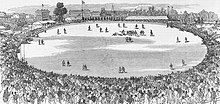
Football became organised in South Australia in 1860 with the formation of the Adelaide Football Club, the oldest football club in Australia outside Victoria.[41] It devised its own rules, and, along with other Adelaide-based clubs, played a variety of codes until 1876, when they uniformly adopted most of the Victorian rules, with South Australian football pioneer Charles Kingston noting their similarity to "the old Adelaide rules".[42] Similarly, Tasmanian clubs quarrelled over different rules until they adopted a slightly modified version of the Victorian game in 1879.[43] The South Australian Football Association (SAFA), the sport's first governing body, formed on 30 April 1877, firmly establishing Victorian rules as the preferred code in that colony.[44] The Victorian Football Association (VFA) formed the following month.

Clubs began touring the colonies in the late 1870s, and in 1879 the first intercolonial match took place in Melbourne between Victoria and South Australia.[45] To standardise the sport across Australia, delegates representing the football associations of South Australia, Tasmania, Victoria and Queensland met in 1883 and updated the code.[43] New rules such as holding the ball led to a "golden era" of fast, long-kicking and high-marking football in the 1880s, a time which also saw players such as George Coulthard achieve superstardom, as well as the rise of professionalism, particularly in Victoria and Western Australia, where the code took hold during a series of gold rushes.[46] Likewise, when New Zealand experienced a gold rush, the sport arrived with a rapid influx of Australian miners. Now known as Australian rules or Australasian rules, the sport became the first football code to develop mass spectator appeal,[45] attracting world record attendances for sports viewing and gaining a reputation as "the people's game".[46]
Australian rules football reached Queensland and New South Wales as early as 1866;[47] the sport experienced a period of dominance in the former,[48] and in the latter, several regions remain strongholds of Australian rules, such as the Riverina. However, by the late 1880s, rugby football had become the dominant code in both colonies, as well as in New Zealand. This shift was largely due to rugby's spread with British migration, regional rivalries and the lack of strong local governing bodies. In the case of Sydney, denial of access to grounds, the influence of university headmasters from Britain who favoured rugby, and the loss of players to other codes inhibited the game's growth.[49]
Emergence of the VFL
[edit]In 1896, delegates from six of the wealthiest VFA clubs—Carlton, Essendon, Fitzroy, Geelong, Melbourne and South Melbourne—met to discuss the formation of a breakaway professional competition.[50] Later joined by Collingwood and St Kilda, the clubs formed the Victorian Football League (VFL), which held its inaugural season in 1897. The VFL's popularity grew rapidly as it made several innovations, such as instituting a finals system, reducing teams from 20 to 18 players, and introducing the behind as a score.[51] Richmond and University joined the VFL in 1908, and by 1925, with the addition of Hawthorn, Footscray and North Melbourne, it had become the preeminent league in the country and would take a leading role in many aspects of the sport.
Interstate football and the World Wars
[edit]
The time around the federation of the Australian colonies in 1901 saw Australian rules undergo a revival in New South Wales, New Zealand and Queensland. In 1903, both the Queensland Australian Football League and the NSW Australian Football Association were established, and in New Zealand, as it moved towards becoming a dominion, leagues were also established in the major cities. This renewed popularity helped encourage the formation of the Australasian Football Council, which in 1908 in Melbourne staged the first national interstate competition, the Jubilee Australasian Football Carnival, with teams representing each state and New Zealand.[52]
The game was also established early on in the new territories. In the new national capital Canberra both soccer and rugby had a head start, but following the first matches in 1911, Australian rules football in the Australian Capital Territory became a major participation sport. By 1981 it had become much neglected and quickly lagged behind the other football codes. Australian rules football in the Northern Territory began shortly after the outbreak of the war in 1916 with the first match in Darwin. The game went on to become the most popular sport in the Territory and build the highest participation rate for the sport nationally.
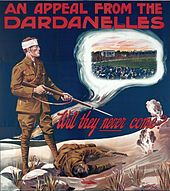
Both World War I and World War II had a devastating effect on Australian football and on Australian sport in general. While scratch matches were played by Australian "diggers" in remote locations around the world, the game lost many of its great players to wartime service. Some clubs and competitions never fully recovered. Between 1914 and 1915, a proposed hybrid code of Australian football and rugby league, the predominant code of football in New South Wales and Queensland, was trialled without success.[53][54] In Queensland, the state league went into recess for the duration of the war. VFL club University left the league and went into recess due to severe casualties. The WAFL lost two clubs and the SANFL was suspended for one year in 1916 due to heavy club losses. The Anzac Day match, the annual game between Essendon and Collingwood on Anzac Day, is one example of how the war continues to be remembered in the football community.
The role of the Australian National Football Council (ANFC) was primarily to govern the game at a national level and to facilitate interstate representative and club competition. In 1968, the ANFC revived the Championship of Australia, a competition first held in 1888 between the premiers of the VFA and SAFA. Although clubs from other states were at times invited, the final was almost always between the premiers from the two strongest state competitions of the time—South Australia and Victoria—with Adelaide hosting most of the matches at the request of the SAFA/SANFL. The last match took place in 1976, with North Adelaide being the last non-Victorian winner in 1972. Between 1976 and 1987, the ANFC, and later the Australian Football Championships (AFC) ran a night series, which invited clubs and representative sides from around the country to participate in a knock-out tournament parallel to the premiership seasons, which Victorian sides still dominated.
With the lack of international competition, state representative matches were regarded with great importance. Due in part to the VFL poaching talent from other states, Victoria dominated interstate matches for three-quarters of a century. State of Origin rules, introduced in 1977, stipulated that rather than representing the state of their adopted club, players would return to play for the state they were first recruited in. This instantly broke Victoria's stranglehold over state titles and Western Australia and South Australia began to win more of their games against Victoria. Both New South Wales and Tasmania scored surprise victories at home against Victoria in 1990.
Towards a national league
[edit]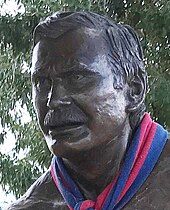
The term "Barassi Line", named after VFL star Ron Barassi, was coined by scholar Ian Turner in 1978 to describe the "fictitious geographical barrier" separating the rugby-following parts of New South Wales and Queensland from the rest of the country, where Australian football reigned.[56] It became a reference point for the expansion of Australian football and for establishing a national league.[57]
The way the game was played had changed dramatically due to innovative coaching tactics, with the phasing out of many of the game's kicking styles and the increasing use of handball; while presentation was influenced by television.[58]
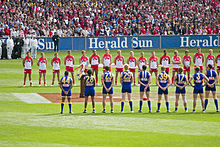
In 1982, in a move that heralded big changes within the sport, one of the original VFL clubs, South Melbourne, relocated to Sydney and became known as the Sydney Swans. In the late 1980s, due to the poor financial standing of many of the Victorian clubs, and a similar situation existing in Western Australia in the sport, the VFL pursued a more national competition. Two more non-Victorian clubs, West Coast and Brisbane, joined the league in 1987 generating more than $8 million in license revenue for the Victorian clubs and increasing broadcast revenues which helped the Victorian clubs survive.[59] In their early years, the Sydney and Brisbane clubs struggled both on and off-field because the substantial TV revenues they generated by playing on a Sunday went to the VFL.[citation needed] To protect these revenues the VFL granted significant draft concessions and financial aid to keep the expansion clubs competitive.
The VFL changed its name to the Australian Football League (AFL) for the 1990 season, and over the next decade, three non-Victorian clubs gained entry: Adelaide (1991), Fremantle (1995) and the SANFL's Port Adelaide (1997), the only pre-existing club outside Victoria to join the league.[59] In 2011 and 2012, respectively, two new non-Victorian clubs were added to the competition: Gold Coast and Greater Western Sydney.[60] The AFL, currently with 18 member clubs, is the sport's elite competition and most powerful body. Following the emergence of the AFL, state leagues were quickly relegated to a second-tier status. The VFA merged with the former VFL reserves competition in 1998, adopting the VFL name. State of Origin also declined in importance, especially after an increasing number of player withdrawals. The AFL turned its focus to the annual International Rules Series against Ireland in 1998 before abolishing State of Origin the following year. State and territorial leagues still contest interstate matches, as do AFL Women players.[61]
In the 2010s, the AFL signalled further attempts at expanding into markets outside Australian football's traditional heartlands by hosting home-and-away matches in New Zealand,[62] followed by China.[63] After several failed bids since the early 1990s for a Tasmania-based AFL team, the Tasmania Football Club secured the 19th AFL license in 2023, and is set to compete by 2028.[64]
Laws of the game
[edit]Players and equipment
[edit]
In a standard match, a team may consist of anywhere between 14 and 18 players who may be permitted on the playing surface at any given time. Each team may have up to four interchange (reserve) players who may be swapped for those on the field at any time during the game.[65] Although some leagues in less populated areas may use as few as 12 players.[66] In addition, some leagues notably including the AFL, have each team designate one additional player as a substitute who can be used to make a single permanent exchange of players during a game for either medical or tactical reasons.[67]
Players on the playing surface can be swapped with those on the interchange bench at any time. They must though pass through a designated "Interchange Area".[68] In the event a player fails to pass through this area correctly, or if too many players from one team are found to be on the ground at a time, a free kick will be awarded to the opposing side.[68][69]
While there is no set uniform, the basic equipment for Australian football consists of a guernsey, shorts, socks and boots, with additional pieces of apparel such as headbands and gloves additionally being permitted.[70] Players may wear certain pieces of protective equipment, such as helmets or arm guards, if approved by the relevant controlling body.[71] Mouthguards are strongly recommended for all players.[72][73]
Players are not permitted to wear jewellery, or other materials which the field umpire has deemed to be either potentially dangerous or increase the risk of injury to other players.[71]
Ball
[edit]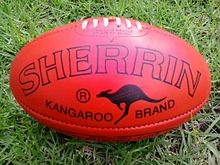
Australian rules football is played with an ellipsoid ball, between 72 and 73 cm (28 and 29 in) in long circumference, and 54.5 and 55.5 cm (21.5 and 21.9 in) in short circumference.[75] For women's competitions, a smaller ball size of 69 and 53 cm (27 and 21 in) is used.[76] The ball must be inflated to a pressure of 69 kilopascals (10.0 pounds per square inch).[75] There are no defined laws regarding what material a ball must be made from, but standard AFL match-used balls are produced by Sherrin using cowhide leather.[77]
While there is no standard colour of the ball, red and yellow are most common and the only colours used at AFL level. Yellow is used for games beginning after 3 pm or in an enclosed stadium, due to its greater visibility, and to assist score reviews.[78][75]
Field
[edit]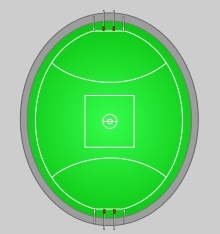
Unlike other forms of football which are played on rectangular fields, Australian rules football playing fields are oval-shaped, and are between 135 and 185 metres (148 and 202 yd) long and 110 and 155 metres (120 and 170 yd) wide.[79]
At either end of the field, two sets of posts are erected in a straight line to indicate the scoring areas on the field, each with two kinds of posts, named the goal posts and the behind posts respectively. The goal posts are placed first, located 6.4 metres (7.0 yd) apart from each other, with a behind post being placed a further 6.4 metres to the side of each goal post. The name for the field line between two goal posts is known as the Goal Line.[79]
Around the perimeter of the field, two white lines are drawn between the set of behind posts in an arc-shape, marking the field of play.[79]
Other field markings include:[79]
- An arc drawn 50 metres (55 yd) from either end of the playing surface, known as the fifty metre arc.
- A 50 by 50 metres (55 yd × 55 yd) square located in the centre of the playing surface, known as the centre square.
- A 10 by 10 metres (11 yd × 11 yd) circle located in the centre of the playing surface, known as the centre circle
- A rectangle drawn at either end of the ground, measuring 9 metres (9.8 yd) out from each pair of goal posts. This is known as the goal square.
The 50m arcs, centre square, centre circle and goal square are used at the beginning of each quarter or after each goal. With each team permitted a maximum of six players in each 50m arc, with one in the goal square and four players in the centre square with one in the centre circle. If this is breached, a free kick is awarded.[80]
Match duration
[edit]A game lasts for 80 minutes, split into four-quarters consisting of 20 minutes playing time, with the clock being stopped for stoppages in play such as scores, or at the umpire's discretion, e.g. for serious injury.[81] Leagues may choose to employ shorter quarters of play at their discretion, such as the AFLW using 17 minutes per quarter.[82]
For any given match, two timekeepers are appointed to officiate the duration. The timekeepers record all relevant statistics for the match, such as total quarter duration and score by each team. Additionally timekeepers are required to sound a siren prior to and at the conclusion of each quarter until such time they are acknowledged by the field umpires. To stop and recommence the clock, the field umpires are required to signal to the timekeepers to indicate when the clock should be stopped or restarted.[81]
Between each quarter, a break is observed to allow players a rest period. Two six-minute breaks are observed between the first and second quarters, and the third and fourth quarters. A longer 20-minute break is observed between the second and third quarter, commonly known as half-time.[81][83]
Officiation
[edit]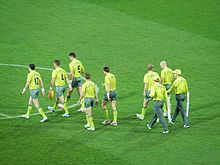
Each game is officiated by at least five match officials, known as an umpire.[84] These match officials are placed into three categories based upon their roles and responsibilities, with varying minimum numbers of Umpires required depending on position:
- Field umpire: Field umpires are positioned within the playing area contained within the Boundary Lines, and are the primary match officials.[84] A minimum of one field umpire is required to officiate the match, though it is common practice to employ more to reduce physical demand on individual umpires, and improve officiation quality.[84][85]
- Boundary umpires: Boundary umpires are positioned along the two boundary lines upon either side of the field. Their primary duties include determining when the football is deemed to be outside of the field of play, and to throw the football back into play when directed. A minimum of two boundary umpires are required for a match.[84]
- Goal umpires: Goal umpires are positioned at either end of the ground, with one stationed at either set of goal posts on the field. Their primary duties include judging what scores made by players, signalling scores, and recording scores made by each team during a match. A minimum of two goal umpires are required for a match.[84]
At AFL level, a video score review system is utilised. Only umpires are permitted to request a review, and only scoring shots and potential scoring shots are permitted to be reviewed.[86]
Game skills
[edit]Ball movement
[edit]An Australian rules football may only be propelled forward in a select few ways as defined by the Laws of Australian Football, published by the AFL. The ball can be propelled in any direction by way of a kick or a clenched fist (called a handball)—deemed a correct disposal.[87] Failure to dispose of the ball in one of these two methods will result in a free kick to the opposing team.[88] If the ball is not currently in a player's possession, it can be moved legally through the usage of other means, such as punching.[87] While in possession of the ball, players may run with the ball, but are required to either bounce or touch the ball on the ground at least once every 15 metres (16 yd).[88]
Tackling
[edit]
Tackling is a technique employed by players used to force opposition players to dispose of the ball when they are in possession. Failure to dispose of the ball when legally tackled may see the player penalised for 'holding the ball', except if the umpire deems there was a lack of prior opportunity to do so.[89]
The ball carrier may only be tackled between the shoulders and knees from the front or side.[87] If the player forcefully contacts the opposing in the back while performing a tackle, the opposition player will be penalised for a push in the back. If the opposition tackles the player with possession below the knees (a low tackle or a trip) or above the shoulders (a high tackle), the team with possession of the football gets a free kick.[90] Furthermore, tackles deemed to be dangerous by the umpire and those conducted from front-on while an opposition player has their head over the football are deemed to be prohibited contact, and will incur a free kick against the offending player.[90][91]
Additionally, players may perform a technique known shepherding when the ball is within 5 metres (5.5 yd) of an opposition player. Shepherding involves the use of a player's body to push, bump or otherwise block an opposition player, providing they do not have possession of the ball.[87]
Marking
[edit]If a player takes possession of the ball that has travelled more than 15 metres (16 yd) from another player's kick, by way of a catch within the field of play, it is deemed as a mark.[92] To be awarded a mark, it must be deemed that the player sufficiently controlled the ball and took possession prior to it being touched, touching the ground, or in the case of a contest, being spoiled by an opponent.[93] Upon a mark being taken, one opposition player may choose to stand on the point on the field where the mark was taken, known as "the mark". When a mark is taken, a small protected zone is established on the field, extending 10 metres (11 yd) either side of "the mark" and the player who marked the ball, with a small protected corridor between "the mark" and the player. The opposition player is permitted to jump, but is not allowed to move from their position on "the mark". Any other movements result in a distance penalty (50 metres in the AFL).[94] The player who was awarded the mark may then choose to either dispose of the ball over "the mark" or may choose to attempt disposal via a different method, in which case the field umpire will call "play on"—a verbal instruction to continue play.[94][87] "Play on" may also be called if the umpire deems the player awarded the mark to be taking an unreasonable amount of time to dispose of the football.[94]
Once the player has disposed of the ball, or "play on" is called, normal play resumes.[94]
Rucking
[edit]
Rucking is the only specialist skill and is performed by a ruck, the term for designated players from each side to which umpire sends the ball to commence play.[95] Only a nominated ruck may contest ball-ups and throw-ins.[96] They are the only player allowed within the 10 metre circle at a centre bounce. Functionally the role is analogous to a basketball center and as such rucks are typically the tallest player on the team. Lifting teammates is not allowed[97] so the ruck may only jump to reach the ball. If the ruck does not take possession of the football, it must must be tapped or fisted, which is known as a hit-out. An effective hit-out that passes the ball to a teammate is known as a hit-out to advantage.[98]
Misconduct
[edit]In the event a player breaks a rule, a free kick is awarded to the opposing team, from the location that the misconduct occurred, or the ball's current location—whichever is closer to the team's scoring zone.[99] As when a mark is taken, this location is called "the mark", and the same protections regarding the space apply.[94]
In the event a player engages in unsportsmanlike conduct after a free kick has been awarded or a mark has been paid to the opposing team, the umpire may instead award a 50-metre penalty. When imposed, the field umpire will advance "the mark" an additional 50 metres (55 yd) down the field or to the goal line, whichever is closer. Additional 50-metre penalties may be awarded if the behaviour continues after the initial penalty.[100]
The laws of the game allow umpires to send off players for egregious foul play, although this law does not apply to the AFL and is largely only used at the local level.[101]
Scoring
[edit]
There are two types of scoring shots in Australian football: goals and behinds. A goal is worth six points, and is scored when the football is propelled between the goal posts and across the goal line at any height by way of a kick from the attacking team. It may touch the ground, but must not have been touched by any player from either team or a goalpost prior to crossing the goal line.[102]
A behind is worth one point and is scored when:[102]
- The ball passes between a goal post and a behind post at any height.
- If the ball hits a goal post.
- If any player sends the ball across the goal or behind line by touching it with any part of the body other than a foot or lower leg.
A behind is also awarded to the team if the ball touches any part of an opposition player, including a foot, before passing across their goal or behind line.[102] A free kick is awarded against any player who is deemed to have deliberately rushed a behind.[103][104]
The team that has scored the most points at the end of play wins the game. If the scores are level on points at the end of play, then the game is a draw; extra time applies only during finals matches in some competitions.[105][106]
As an example of a score report, consider a match between Sydney and Geelong with the former as the home team. Sydney's score of 17 goals and 5 behinds equates to 107 points. Geelong's score of 10 goals and 17 behinds equates to a 77-point tally. Sydney wins the match by a margin of 30 points. Such a result would be written as:
- "Sydney 17.5 (107) defeated Geelong 10.17 (77)".
And spoken as:
- "Sydney, seventeen-five, one hundred and seven, defeated Geelong, ten-seventeen, seventy-seven".
Additionally, it can be said that:
- "Sydney defeated Geelong by 30 points".
The home team is typically listed first and the visiting side is listed second.
A draw would be written as:
- "Greater Western Sydney 10.8 (68) drew with Geelong 10.8 (68)".[107]
Structure and competitions
[edit]The football season proper is from March to August (early autumn to late winter in Australia) with finals being held in September and October.[108] In the tropics, the game is sometimes played in the wet season (October to March).[109]
The AFL is recognised by the Australian Sports Commission as being the National Sporting Organisation for Australian football.[110] There are also seven state/territory-based organisations in Australia, all of which are affiliated with the AFL.[111] These state leagues hold annual semi-professional club competitions, with some also overseeing more than one league. Local semi-professional or amateur organisations and competitions are often affiliated to their state organisations.[112]
In 2002, the AFL became the de facto world governing body for Australian football when it pushed for the closure of the International Australian Football Council. There are also a number of affiliated organisations governing amateur clubs and competitions around the world.[113]
For almost all Australian football club competitions, the aim is to win the Premiership. The premiership is typically decided by a finals series. The teams that occupy the highest positions on the ladder after the home-and-away season play-off in a "semi-knockout" finals series, culminating in a single Grand Final match to determine the premiers. Between four and eight teams contest a finals series, typically using the AFL final eight system[114] or a variation of the McIntyre system.[115][116] The team which finishes first on the ladder after the home-and-away season is referred to as a "minor premier", but this usually holds little stand-alone significance, other than receiving a better draw in the finals.[117]
Some metropolitan leagues have several tiered divisions, with promotion of the lower division premiers and relegation of the upper division's last placed team at the end of each year.[118]
Women and Australian football
[edit]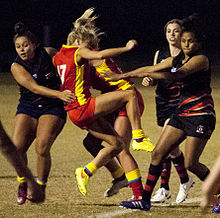
The high level of interest shown by women in Australian football is considered unique among the world's football codes.[119] It was the case in the 19th century, as it is in modern times, that women made up approximately half of total attendances at Australian football matches—a far greater proportion than, for example, the estimated 10 per cent of women that comprise British soccer crowds.[120] This has been attributed in part to the egalitarian character of Australian football's early years in public parks where women could mingle freely and support the game in various ways.[121]
In terms of participation, there are occasional 19th-century references to women playing the sport, but it was not until the 1910s that the first organised women's teams and competitions appeared.[122] Women's state leagues emerged in the 1980s,[123] and in 2013, the AFL announced plans to establish a nationally televised women's competition.[124] Amidst a surge in viewing interest and participation in women's football, the AFL pushed the founding date of the competition, named AFL Women's, to 2017.[125] Eight AFL clubs won licences to field sides in its inaugural season.[126] By the seventh season, which began in August 2022, all 18 clubs fielded a women's side.
Variations and related sports
[edit]Many related games have emerged from Australian football, mainly with variations of contact to encourage greater participation. These include Auskick (played by children aged between 5 and 12), kick-to-kick (and its variants end-to-end footy and marks up), rec footy, 9-a-side footy, masters Australian football, handball and longest-kick competitions. Players outside Australia sometimes engage in related games adapted to available fields, like metro footy (played on gridiron fields) and Samoa rules (played on rugby fields). One such prominent example in use since 2018 is AFLX, a shortened variation of the game with seven players a side, played on a soccer-sized pitch.[127]
International rules football
[edit]The similarities between Australian football and the Irish sport of Gaelic football have allowed for the creation of a hybrid code known as international rules football. The first international rules matches were contested in Ireland during the 1967 Australian Football World Tour. Since then, various sets of compromise rules have been trialed, and in 1984 the International Rules Series commenced with national representative sides selected by Australia's state leagues (later by the AFL) and the Gaelic Athletic Association (GAA). The competition became an annual event in 1998, but was postponed indefinitely in 2007 when the GAA pulled out due to Australia's severe and aggressive style of play.[128] It resumed in Australia in 2008 under new rules to protect the player with the ball.
Global reach
[edit]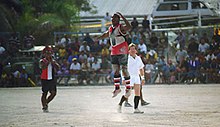
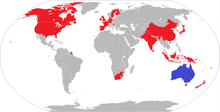
During the colonial period, Australian rules was sometimes referred to as Australasian rules, reflecting its popularity in New Zealand. The game was played outside Australasia as early as 1888 when Australians studying at Edinburgh University and London University formed teams and competed in London.[129] By the early 20th century, it had spread with the Australian diaspora to South Africa, the United States and other parts of the Anglosphere; however this growth went into rapid decline during and after World War I, leading also to a decades long hiatus in New Zealand. After World War II, it experienced growth in the Pacific region, particularly in Papua New Guinea and Nauru, where Australian football is now the national sport.[130]
Today, the sport is played at an amateur level in various countries throughout the world. Twenty-three countries have participated in the International Cup, the highest level of international competition, held triennially in Australia since 2002. Nine countries have also participated in the AFL Europe Championship with both competitions prohibiting Australian players. A fan of the sport since attending school in Victoria, King Charles is the Patron of AFL Europe. In 2013, participation across AFL Europe's 21 member nations was more than 5,000 players, the majority of which are European nationals rather than Australian expats.[131] The sport also has a growing presence in India.[132] Over 20 countries have either affiliation or working agreements with the AFL.[133]
Most present-day international amateur clubs and leagues are based in North America, Europe and Asia, with the oldest typically having originated in the 1980s. That decade, the sport developed a cult following in the United States when matches were broadcast on the fledgling ESPN network.[134] Growing international interest has been assisted by exhibition matches, players switching between football codes, and Australia's multicultural makeup. Many VFL/AFL players were born overseas, with a growing number recruited through various initiatives. One notable example is the Irish experiment, which, since the 1980s, has seen many Gaelic footballers leave the amateur GAA to play Australian rules professionally, this has expanded to the AFLW, where it has grown from 1 Irish player in the debut 2017 season, to 36 in 2024.[135]
Although Australian rules football is not an Olympic sport, it was showcased at the MCG as part of the 1956 Summer Olympics, held in Melbourne. In addition, when Brisbane hosted the 1982 Commonwealth Games, an exhibition match was held at the Gabba.[136]
Cultural impact and popularity
[edit]
Australian football has attracted more overall interest among Australians than any other football code,[137] and, when compared with all sports throughout the nation, has consistently ranked first in the winter reports, and third behind cricket and swimming in summer.[138] Over 1,057,572 fans were paying members of AFL clubs in 2019.[139] The 2021 AFL Grand Final was the year's most-watched television broadcast in Australia, with an in-home audience of up to 4.11 million.[140][141]
In 2019, there were 1,716,276 registered participants in Australia[139] including 586,422 females (34 per cent of the overall total) and more than 177,000 registered outside Australia including 79,000 females (45 per cent of the overall total).[139]
In the arts and popular culture
[edit]
Australian football has inspired many literary works,[142] from poems by C. J. Dennis and Peter Goldsworthy, to the fiction of Frank Hardy and Kerry Greenwood. Historians Manning Clarke and Geoffrey Blainey have also written extensively on the sport. Slang within Australian football has impacted Australian English more broadly, with a number of expressions taking on new meanings in non-sporting contexts, e.g., to "get a guernsey" is to gain recognition or approval, while "shirt-fronting" someone is to accost them.[143]
In 1889, Australian impressionist painter Arthur Streeton captured football games en plein air for the 9 by 5 Impression Exhibition, titling one work The National Game.[144] Paintings by Sidney Nolan (Footballer, 1946) and John Brack (Three of the Players, 1953) helped to establish Australian football as a serious subject for modernists,[145] and many Aboriginal artists have explored the game, often fusing it with the mythology of their region.[146][147] In cartooning, WEG's VFL/AFL premiership posters—inaugurated in 1954—have achieved iconic status among Australian football fans.[148] Australian football statues can be found throughout the country, some based on famous photographs, among them Haydn Bunton Sr.'s leap, Jack Dyer's charge and Nicky Winmar lifting his jumper.[149] In the 1980s, a group of postmodern architects based in Melbourne began incorporating references to Australian football into their buildings, an example being Building 8 by Edmond and Corrigan.[150][151]
Dance sequences based on Australian football feature heavily in Robert Helpmann's 1964 ballet The Display, his first and most famous work for the Australian Ballet.[152] The game has also inspired well-known plays such as And the Big Men Fly (1963) by Alan Hopgood and David Williamson's The Club (1977), which was adapted into a 1980 film, directed by Bruce Beresford. Mike Brady's 1979 hit "Up There Cazaly" is considered an Australian football anthem, and references to the sport can be found in works by popular musicians, from singer-songwriter Paul Kelly to the alternative rock band TISM.[153] Many Australian football video games have been released, most notably the AFL series.
Australian Football Hall of Fame
[edit]For the centenary of the VFL/AFL in 1996, the Australian Football Hall of Fame was established. That year, 136 significant figures across the various competitions were inducted into the Hall of Fame. Each years since the creation of the Hall of Fame, a panel selects a small group of players they deem worthy for this prestigious honour, resulting in a total number of more than 300 inductees as of 2024.
In addition to the Hall of Fame, select members are chosen to receive the elite Legend status. Due to restrictions limiting the number of Legend status players to 10% of the total number of Hall of Fame inductees, there are currently only 32 players with the status in the Hall of Fame as of 2024.[154][155][156]
See also
[edit]- Australian rules football attendance records
- Australian rules football positions
- List of Australian rules football clubs
- List of Australian rules football rivalries
- List of Australian rules football terms
References
[edit]Citations
[edit]- ^ a b Collins, Ben (22 November 2016). "Women's football explosion results in record participation" Archived 22 November 2016 at the Wayback Machine, AFL. Retrieved 22 November 2016.
- ^ "About the AFL: Australian Football (Official title of the code)". Australian Football League. Archived from the original on 3 December 2013. Retrieved 20 June 2017.
- ^ 2012 Laws of the game Archived 22 May 2012 at the Wayback Machine Section 14, page 45
- ^ History Archived 13 December 2007 at the Wayback Machine Official Website of the Australian Football League
- ^ Wendy Lewis; Simon Balderstone; John Bowan (2006). Events That Shaped Australia. New Holland. p. 61. ISBN 978-1-74110-492-9.
- ^ Kwek, Glenda (26 March 2013). "AFL leaves other codes in the dust" Archived 6 November 2016 at the Wayback Machine, The Sydney Morning Herald. Retrieved 18 December 2016.
- ^ "AFL is clearly Australia's most watched Football Code, while V8 Supercars have the local edge over Formula 1" Archived 6 August 2020 at the Wayback Machine (14 March 2014), Roy Morgan. Retrieved 18 December 2016.
- ^ "The richest codes in world sport: Forget the medals, these sports are chasing the gold" (8 May 2014). Courier Mail. Retrieved 9 October 2016.
- ^ "History website". Footy.com.au. Archived from the original on 19 February 2010. Retrieved 19 February 2010.
- ^ Connolly, Rohan (22 March 2012). "Name of the game is up in the air in NSW". The Age. Archived from the original on 6 November 2013. Retrieved 4 April 2012.
- ^ First Australian Rules Game Archived 27 September 2013 at the Wayback Machine, Monument Australia. Retrieved 18 June 2013.
- ^ Hess 2008, pp. 1–3.
- ^ Pennings 2012, p. 8.
- ^ Pennings 2012, pp. 13–14.
- ^ de Moore 2011, pp. 86–87.
- ^ Pennings 2012, p. 14.
- ^ Blainey 2010, pp. 23–26.
- ^ Ken Piesse (1995). The Complete Guide to Australian Football. Pan Macmillan Australia. p. 303. ISBN 0-330-35712-3.
- ^ Paproth, Daniel (4 June 2012). "The oldest of school rivals". The Weekly Review Stonnington. Archived from the original on 3 December 2013. Retrieved 19 June 2013.
- ^ Collins, Tony (2011). "Chapter 1: National Myths, Imperial Pasts and the Origins of Australian Rules Football". In Wagg, Stephen (ed.). Myths and Milestones in the History of Sport. Palgrave Macmillan. p. 14. ISBN 978-0-230-24125-1.
- ^ Blainey 2010, pp. 187–196.
- ^ Hibbins & Ruddell 2009, p. 8.
- ^ de Moore 2011, pp. 322–323.
- ^ Pennings 2012, p. 15.
- ^ Pennings 2012, p. 11.
- ^ Hibbins & Ruddell 2009, pp. 14–15.
- ^ a b Coventry 2015, p. 2.
- ^ Pennings 2012, p. 9.
- ^ Hibbins & Ruddell 2009, p. 7.
- ^ Hibbins & Ruddell 2009, p. 17.
- ^ Hibbins & Ruddell 2009, pp. 10–12.
- ^ Hibbins & Ruddell 2009, p. 11.
- ^ Pennings 2012, p. 25.
- ^ Hibbins & Ruddell 2009, p. 20.
- ^ Hibbins & Ruddell 2009, pp. 18–20.
- ^ Hibbins & Ruddell 2009, pp. 22–23.
- ^ Coventry 2015, pp. 16–17, 20.
- ^ Hibbins & Ruddell 2009, p. 9.
- ^ de Moore 2011, pp. 87, 288–289.
- ^ a b Hess 2008, p. 44.
- ^ Pill, Shane; Frost, Lionel (17 January 2016). "R.E.N. Twopeny and the Establishment of Australian Football in Adelaide". The International Journal of the History of Sport. 33 (8): 797–812. doi:10.1080/09523367.2016.1173033. S2CID 147807924.
- ^ Hibbins & Ruddell 2010, pp. 22–24.
- ^ a b Hibbins & Ruddell 2010, p. 24.
- ^ Hibbins & Ruddell 2010, pp. 22–23.
- ^ a b Blainey 2010, pp. 107–108.
- ^ a b Pennings 2013.
- ^ de Moore et al. 2021, pp. 186–188.
- ^ Pramberg, Bernie (15 June 2015). "Love of the Game: Aussie rules a dominant sport in early Queensland" Archived 11 March 2022 at the Wayback Machine, The Courier-Mail. Retrieved 24 April 2016.
- ^ Healy, Matthew (2002). Hard Sell: Australian Football in Sydney (PDF). Archived 18 March 2018 at the Wayback Machine. Melbourne, Vic.: Victoria University. pp. 20–28.
- ^ Nauright & Parrish 2012, p. 351.
- ^ Nauright & Parrish 2012, p. 351–352.
- ^ "A False Dawn". AustralianFootball.com. 20 August 1908. Archived from the original on 14 July 2015. Retrieved 19 February 2010.
- ^ "Football in Australia". Evening Post, Volume LXXXVIII, Issue 122. New Zealand. 19 November 1914. p. 8. Archived from the original on 1 April 2012. Retrieved 3 December 2009.
- ^ "Football amalgamation". Evening Post, Volume LXXXIX, Issue 27. New Zealand. 2 February 1915. p. 8. Archived from the original on 1 April 2012. Retrieved 3 December 2009.
- ^ "Vale Ron Barassi" Archived 19 September 2023 at the Wayback Machine, AFL. Retrieved 20 September 2023.
- ^ Marshall, Konrad (26 February 2016). "Where do rugby codes' strongholds turn to rules? At the 'Barassi Line', of course..." Archived 14 February 2017 at the Wayback Machine, The Sydney Morning Herald. Retrieved 21 April 2016.
- ^ Referenced in Hutchinson, Garrie (1983). The Great Australian Book of Football Stories. Melbourne: Currey O'Neil.
- ^ WICKS, B. M. Whatever Happened to Australian Rules? Hobart, Tasmania, Libra Books. 1980, First Edition. (ISBN 0-909619-06-9)
- ^ a b Nauright & Parrish 2012, p. 342.
- ^ Nauright & Parrish 2012, p. 341.
- ^ Big names locked in for AFLW state of origin Archived 28 July 2017 at the Wayback Machine. AFL News, 25 July 2017
- ^ Cherny, Daniel; Wilson, Caroline (31 May 2016). "AFL 2016: St Kilda want two 2018 games in Auckland" Archived 23 December 2016 at the Wayback Machine, The Age. Retrieved 1 November 2016.
- ^ "Port Adelaide, Gold Coast Suns take AFL to China in 2017 regular season" Archived 1 November 2016 at the Wayback Machine (26 October 2016), ABC News. Retrieved 1 November 2016.
- ^ Holmes, Adam (18 March 2024). "Tasmania Devils AFL club launched with name, colours, logo and guernsey concept revealed" Archived 18 March 2024 at the Wayback Machine, ABC News. Retrieved 19 March 2024.
- ^ "Pre-Match Provisions – Teams and Players" (PDF). Laws of Australian Football 2022. AFL. Archived (PDF) from the original on 3 March 2024. Retrieved 3 March 2024.
- ^ Story Carter, Jeremy (3 August 2023). "Kick in hope". ABC News. Archived from the original on 27 March 2024. Retrieved 27 March 2024.
- ^ Rogers, Michael (21 December 2022). "No vests: AFL reveals details of revamped sub rule". afl.com.au. Archived from the original on 3 March 2024. Retrieved 3 March 2024.
- ^ a b "Pre-Match Provisions – Interchange" (PDF). Laws of Australian Football 2022. AFL. Archived (PDF) from the original on 3 March 2024. Retrieved 3 March 2024.
- ^ "Pre-Match Provisions – Counting of Players" (PDF). Laws of Australian Football 2022. AFL. Archived (PDF) from the original on 3 March 2024. Retrieved 3 March 2024.
- ^ "Clubs and Uniforms" (PDF). Australian Football League Regulations. AFL. Archived (PDF) from the original on 11 November 2020. Retrieved 3 March 2024.
- ^ a b "Pre-Match Provisions – Protective Equipment" (PDF). Laws of Australian Football 2022. AFL. Archived (PDF) from the original on 3 March 2024. Retrieved 3 March 2024.
- ^ "Role of helmets & mouthguards in Australian Football" (PDF). AFL.com.au. Archived (PDF) from the original on 3 April 2024.
- ^ Lynch, Gordon S. (31 July 2006). "Mouthguards Insure Against Injury". afl.com.au. Archived from the original on 3 April 2024.
- ^ "Corporate Partners". afl.com.au. Archived from the original on 3 March 2024. Retrieved 3 March 2024.
- ^ a b c "Pre-Match Provisions – The Football" (PDF). Laws of Australian Football 2022. AFL. Archived (PDF) from the original on 3 March 2024. Retrieved 3 March 2024.
- ^ "Size Chart". Sherrin. Archived from the original on 3 March 2024. Retrieved 3 March 2024.
- ^ "Frequently Asked Questions". Sherrin. Archived from the original on 3 March 2024. Retrieved 3 March 2024.
- ^ Ryan, Peter (21 August 2015). "Is red nearly dead? Yellow Sherrins making their move" Archived 27 March 2024 at the Wayback Machine, AFL. Retrieved 27 March 2024.
- ^ a b c d "Pre-Match Provisions – Playing Surface" (PDF). AFL. Archived (PDF) from the original on 3 March 2024. Retrieved 3 March 2024.
- ^ "STARTING POSITIONS" (PDF). AFL. Archived (PDF) from the original on 28 March 2024. Retrieved 28 March 2024.
- ^ a b c "Pre-Match Provisions – Match Timing" (PDF). AFL. Archived (PDF) from the original on 3 March 2024. Retrieved 3 March 2024.
- ^ "AFLW Rules". afl.com.au/aflw. Archived from the original on 3 March 2024. Retrieved 3 March 2024.
- ^ "Time to cut half-time breaks? AFL makes the call". afl.com.au. 1 February 2020. Archived from the original on 3 March 2024. Retrieved 3 March 2024.
- ^ a b c d e "Pre-Match Provisions – Umpires" (PDF). afl.com.au. AFL. Archived (PDF) from the original on 3 March 2024. Retrieved 4 March 2024.
- ^ "AFL confirms four field umpires for 2023 season". afl.com.au. 1 March 2023. Archived from the original on 11 March 2023. Retrieved 4 March 2024.
- ^ "Score Review Powerpoint" (PDF). afl.com.au. Archived (PDF) from the original on 28 March 2024. Retrieved 28 March 2024.
- ^ a b c d e "Definitions, Interpretations and Variation" (PDF). afl.com.au. Archived (PDF) from the original on 3 March 2024. Retrieved 4 March 2024.
- ^ a b "Match Provisions – Free Kicks (Other)" (PDF). afl.com.au. Archived (PDF) from the original on 3 March 2024. Retrieved 4 March 2024.
- ^ "Match Provisions – Holding the Ball" (PDF). afl.com.au. Archived (PDF) from the original on 3 March 2024. Retrieved 4 March 2024.
- ^ a b "Match Provisions – Prohibited Contact" (PDF). afl.com.au. Archived (PDF) from the original on 3 March 2024. Retrieved 4 March 2024.
- ^ "Match Provisions – Rough Conduct" (PDF). afl.com.au. AFL. Archived (PDF) from the original on 3 March 2024. Retrieved 4 March 2024.
- ^ "Match Provisions – Marking" (PDF). afl.com.au. Archived (PDF) from the original on 3 March 2024. Retrieved 4 March 2024.
- ^ "Laws of Australian Football 2024" (PDF). Australian Football League. 2024. p. 51. Retrieved 13 November 2024.
- ^ a b c d e "Match Provisions – Disposal After Mark" (PDF). afl.com.au. Archived (PDF) from the original on 3 March 2024. Retrieved 4 March 2024.
- ^ "Laws of Australian Football 2024" (PDF). Australian Football League. 2024. p. 38. Retrieved 13 November 2024.
- ^ "Laws of Australian Football 2024" (PDF). Australian Football League. 2024. p. 40. Retrieved 13 November 2024.
- ^ "Laws of Australian Football 2024" (PDF). Australian Football League. 2024. p. 58. Retrieved 13 November 2024.
- ^ Stats glossary: Every stat explained from AFL 28 December 2017
- ^ "Match Provisions – Free Kicks" (PDF). afl.com.au. Archived (PDF) from the original on 3 March 2024. Retrieved 4 March 2024.
- ^ "Match Provisions – Fifty Metre Penalties" (PDF). afl.com.au. Archived (PDF) from the original on 3 March 2024. Retrieved 4 March 2024.
- ^ "The AFL says it has no plans for a 'red card' rule — but Tom Stewart's hit on Dion Prestia has put the spotlight back on the debate". ABC News. 28 June 2022. Archived from the original on 28 March 2024. Retrieved 28 March 2024.
- ^ a b c "Match Provisions – Scoring" (PDF). afl.com.au. Archived (PDF) from the original on 3 March 2024. Retrieved 4 March 2024.
- ^ "AFL rules on deliberate rushed behinds". Archived from the original on 5 October 2012. Retrieved 27 February 2011.
- ^ "All clear for rushed behind rule". Herald Sun.
- ^ "Laws of Australian Football – Introduction" (PDF). afl.com.au. Archived (PDF) from the original on 3 March 2024. Retrieved 4 March 2024.
- ^ "What happens if the Grand Final is a draw? The AFL explains". afl.com.au. 23 October 2020. Archived from the original on 4 March 2024. Retrieved 4 March 2024.
- ^ "Greater Western Sydney v Geelong". AFL Tables. 1 July 2017. Archived from the original on 13 September 2017. Retrieved 13 September 2017.
- ^ "Schedule – By Round" (PDF). 20 March 2007. Archived from the original (PDF) on 20 March 2007.
- ^ Finlayson, Sean (30 November 2006). "Bombers soaring on the Tiwi Islands". World Footy News. Archived from the original on 13 July 2015. Retrieved 11 November 2015.
- ^ "Australian Institute of Sport – Australian football". Australian Institute of Sport. Archived from the original on 24 July 2008. Retrieved 19 February 2010.
- ^ "Inquiry into Country Football" (PDF). Archived (PDF) from the original on 8 March 2021. Retrieved 6 April 2021.
- ^ "LEAGUES & ASSOCIATIONS". AFL Victoria. Archived from the original on 11 April 2021. Retrieved 11 April 2021.
- ^ "International – Official Website of the Australian Football League". Australian Football League. Archived from the original on 29 May 2010. Retrieved 19 February 2010.
- ^ "Australian Football League Regulations" (PDF). Archived (PDF) from the original on 11 November 2020. Retrieved 6 April 2021.
- ^ "Adelaide Footy League – Rules & Regulations". Archived from the original on 24 September 2021. Retrieved 6 April 2021.
- ^ "Explaining the Final Six". VAFA. 22 July 2013. Archived from the original on 14 August 2021. Retrieved 6 April 2021.
- ^ Cellini, Aiden (9 March 2023). "Chris Scott's wish granted as AFL "recognises the minor premier" in combined AFL, AFLW McClelland Trophy | Sporting News Australia". www.sportingnews.com. Archived from the original on 6 July 2023. Retrieved 4 March 2024.
- ^ "Rules of the Victorian Amateur Football Association" (PDF). Archived (PDF) from the original on 13 July 2021. Retrieved 6 April 2021.
- ^ Mewett & Toffoletti 2008, p. 2.
- ^ Hess 2008, p. 66.
- ^ Browne, Ashley (2008). "For Women, Too". In Weston, James. The Australian Game of Football: Since 1858. Geoff Slattery Publishing. pp. 253–259. ISBN 978-0-9803466-6-4.
- ^ Hess & Lenkic 2016, pp. 1–6.
- ^ Pippos 2017, p. 191.
- ^ Lane, Samantha (27 March 2013). "AFL sees the light on women's footy" Archived 23 August 2014 at the Wayback Machine, The Age. Retrieved 29 November 2014.
- ^ Halloran, Jessica (29 January 2017). "Will the AFL Women's League level the playing field?" Archived 24 September 2021 at the Wayback Machine, The Daily Telegraph. Retrieved 28 April 2018.
- ^ Mark, David (17 June 2016). "AFL women's competition provides a pathway for young women into professional sport" Archived 1 April 2018 at the Wayback Machine, ABC. Retrieved 28 April 2018.
- ^ "AFLX revealed: Who your club plays". AFL.com.au. 17 November 2017. Archived from the original on 17 November 2017. Retrieved 17 November 2017.
- ^ Haxton, Nance (3 January 2007). "Sounds of Summer: International Rules Series" Archived 31 July 2016 at the Wayback Machine. PM, ABC Radio National. Retrieved 1 May 2016.
- ^ Williamson 2003, pp. 138–140.
- ^ Roffey, Chelsea (30 July 2008). "Team Profile: Nauru Chiefs". Afl.com.au. Archived from the original on 25 January 2009. Retrieved 19 February 2010.
- ^ "The Prince of Wales becomes Patron of AFL Europe". princeofwales.gov.uk. 25 October 2013. Archived from the original on 4 November 2013. Retrieved 3 November 2012.
- ^ Rith Basu, Ayan Paul (2 November 2015). "Soccer city gets a taste of Aussie football". Archived from the original on 6 November 2015. Retrieved 3 November 2015.
- ^ AFL International Development Archived 21 November 2008 at the Wayback Machine
- ^ Delaney, Tim; Madigan, Tim (2009). The Sociology of Sports: An Introduction. McFarland. pp. 284–285. ISBN 978-0786453153.
- ^ Vinall, Marnie (28 October 2024). "Attacking flair, speed and a knack for scoring: How the Irish influx is shaping the AFLW". Retrieved 11 November 2024.
- ^ Greenberg, Tony (4 April 2018). "When the Tigers won Games gold". RichmondFC.com.au. Richmond Football Club. Archived from the original on 31 July 2022. Retrieved 31 July 2022.
- ^ "Sweeney Sport report for 2006–07" (PDF). Archived from the original (PDF) on 27 May 2008. Retrieved 31 March 2021.
- ^ Derriman, Philip (22 May 2003). "If you can kick it, Australia will watch it". The Sydney Morning Herald. Archived from the original on 27 February 2014. Retrieved 22 November 2005.
- ^ a b c "AFL Annual Report 2019" (PDF). Archived (PDF) from the original on 22 March 2020.
- ^ "2021 Toyota AFL Grand Final TV Audience". afl.com.au. 26 September 2021. Archived from the original on 2 December 2021. Retrieved 27 September 2021.
- ^ Bruce, Jasper (26 September 2021). "Insane stat proves AFL is king". news.com.au. Archived from the original on 2 December 2021. Retrieved 27 September 2021.
- ^ Alomes, Stephen (2007), "The Lie of the Ground: Aesthetics and Australian Football", Double Dialogues (8), Deakin University, ISSN 1447-9591, archived from the original on 2 June 2015
- ^ "Shirtfronting" Archived 27 March 2023 at the Wayback Machine, Cambridge Dictionary. Retrieved 29 March 2022.
- ^ Clark, Jane (1985). Golden Summers: Heidelberg and Beyond, pp. 112–117
- ^ McAullife, Chris (1995). "Eyes on the Ball: Images of Australian Rules Football", Art & Australia (Vol 32 No 4), pp. 490–500
- ^ Heathcote, Christopher (August 2009). "Bush Football: The Kunoth Family", Art Monthly (Issue 222).
- ^ Angel, Anita (23 November 2009). "Looking at Art" Archived 23 May 2014 at the Wayback Machine, Charles Darwin University Art Collection & Art Gallery. Retrieved 23 May 2014.
- ^ Rielly, Stephen (30 December 2008). "Cartoonist William Ellis Green spoke to AFL tribe", The Australian. Retrieved 5 December 2013.
- ^ Green, Warwick (16 September 2018). "From photo to statue: Winmar's stance still powerful" Archived 31 March 2022 at the Wayback Machine, The Age. Retrieved 31 March 2022.
- ^ Reinmuth, Gerard (2019). "Reflection on Wars Past". In Sydney vs Melbourne. UTS Architecture, p. 54. ISBN 978-3-16-148410-0.
- ^ Van Schaik, Leon (1996). In Building 8: 10 Essays. Schwarz Transition, pp. 48–53. ISBN 978-1-863-95314-6.
- ^ Douglas, Tim (30 August 2012). "Ballet's former glories show footy's left its mark" Archived 21 January 2015 at the Wayback Machine, The Australian. Retrieved 8 June 2014.
- ^ Worrell, Shane (3 April 2010). "Modern footy not in tune" Archived 24 September 2021 at the Wayback Machine, Bendigo Advertiser. Retrieved 5 December 2013.
- ^ "AFL – News, Fixtures, Scores & Results". afl.com.au. Retrieved 12 November 2023.
- ^ "Hawks great Jason Dunstall joins Hall of Fame Legends". afl.com.au. 15 April 2024. Retrieved 15 April 2024.
- ^ "Jason Dunstall's epic resume complete after elevation to Legend status in Australian Football Hall of Fame". Fox Sports. 15 April 2024. Retrieved 15 April 2024.
Sources
[edit]Books
[edit]- Blainey, Geoffrey (2010). A Game of Our Own: The Origins of Australian Football. Black Inc. ISBN 9781863954853.
- Coventry, James (2015). Time and Space: The Tactics That Shaped Australian Rules and the Players and Coaches Who Mastered Them. HarperCollins. ISBN 978-0-7333-3369-9.
- de Moore, Greg (2011). Tom Wills: First Wild Man of Australian Sport. Allen & Unwin. ISBN 978-1-74237-598-4.
- de Moore, Greg; Hess, Rob; Nicholson, Matthew; Stewart, Bob (2021). Australia's Game: The History of Australian Football. Hardie Grant Books. ISBN 9781-74379-657-3.
- Hess, Rob (2008). A National Game: The History of Australian Rules Football. Viking. ISBN 978-0-670-07089-3.
- Hess, Rob; Lenkic, Brunette (2016). Play On! The Hidden History of Women's Australian Rules Football. Bonnier Zaffre. ISBN 9781760063160.
- Hibbins, Gillian; Mancini, Anne (1987). Running with the Ball: Football's Foster Father. Lynedoch Publications. ISBN 978-0-7316-0481-4.
- Hibbins, Gillian (2008). "Men of Purpose". In Weston, James (ed.). The Australian Game of Football: Since 1858. Geoff Slattery Publishing. pp. 31–45. ISBN 978-0-9803466-6-4.
- Hibbins, Gillian (2013). "The Cambridge Connection: The English Origins of Australian Football". In Mangan, J. A. (ed.). The Cultural Bond: Sport, Empire, Society. Routledge. pp. 108–127. ISBN 9781135024376.
- Nauright, John; Parrish, Charles (2012). Sports Around the World: History, Culture, and Practice. ABC-CLIO. ISBN 9781598843002.
- Pennings, Mark (2012). Origins of Australian Football: Victoria's Early History: Volume 1: Amateur Heroes and the Rise of Clubs, 1858 to 1876. Connor Court Publishing Pty Ltd. ISBN 9781921421471.
- Pippos, Angela (2017). Breaking the Mould. Simon and Schuster. ISBN 9781925475296.
- Williamson, John (2003). Bucknell, Mar (ed.). Football's Forgotten Tour: The Story of the British Australian Rules Venture of 1888. Applegate. ISBN 9780958101806.
Journal and conference articles
[edit]- Hibbins, Gillian; Ruddell, Trevor (2009). "'A Code of Our Own': Celebrating 150 Years of the Rules of Australian Football" (PDF). The Yorker (39). Archived (PDF) from the original on 2 April 2015. Retrieved 3 March 2016.
- Hibbins, Gillian; Ruddell, Trevor (2010). "The Evolution of the Rules of Football From 1872 to 1877" (PDF). The Yorker (41). Archived (PDF) from the original on 16 November 2019. Retrieved 6 June 2018.
- Mewett, Peter; Toffoletti, Kim (2008). The Strength of Strong Ties: How Women Become Supporters of Australian Rules Football. Australian Sociological Association Conference. University of Melbourne. ISBN 9780734039842.
- Pennings, Mark (2013). "Fuschias, Pivots, Same Olds and Gorillas: The Early Years of Football in Victoria" (PDF). Tablet to Scoreboard. 1 (1). Archived (PDF) from the original on 3 March 2016. Retrieved 29 March 2016.
External links
[edit]- Australian Football League (AFL) official website
- Australian Football: Celebrating The History of the Great Australian Game
- 2020 Laws of Australian Football
- Australian Football explained in 31 languages – a publication from AFL.com.au
- Reading Australian Rules Football – The Definitive Guide to the Game
- State Library of Victoria Research Guide to Australian Football


